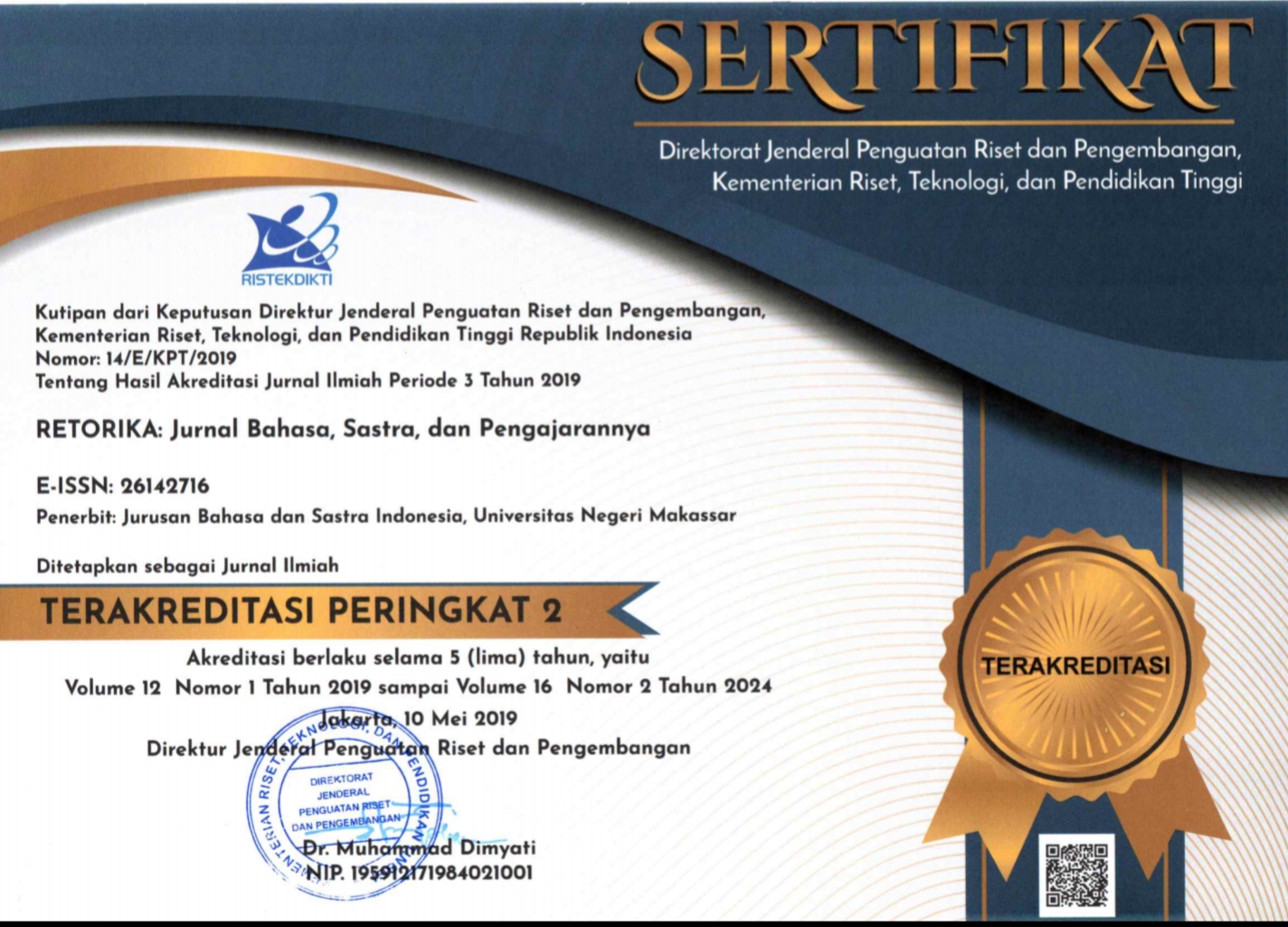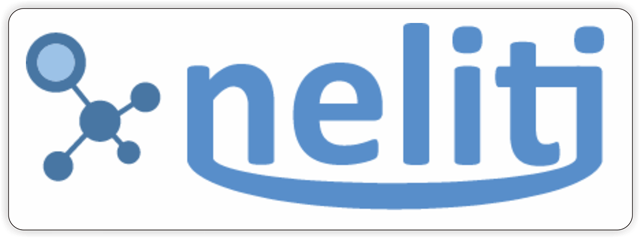STIMULATION OF THE EARLY CHILDHOOD LANGUAGE DEVELOPMENT: OPTIMALIZATION OF A MOTHER’S ROLE IN FAMILY EDUCATION
(1) Scopus ID: 57208211262, Universitas Negeri Makassar, Indonesia
(2)
(*) Corresponding Author
DOI: https://doi.org/10.26858/retorika.v13i1.12300
Abstract
Full Text:
PDFReferences
AlHammadi, F. S. (2017). Prediction of child language development: A review of literature in early childhood communication disorders. Lingua, 199, 27–35. https://doi.org/10.1016/j.lingua.2017.07.007
Blanden, J., Great Britain, Department for Work and Pensions, University of Surrey, Department of Economics, London School of Economics and Political Science, & Centre for Economic Performance. (2006). “Bucking the trend”: what enables those who are disadvantaged in childhood to succeed later in life. Corporate Document Services.
Cabrera, N. J., Shannon, J. D., & Tamis-LeMonda, C. (2007). Fathers’ Influence on Their Children’s Cognitive and Emotional Development: From Toddlers to Pre-K. Applied Developmental Science, 11(4), 208–213. https://doi.org/10.1080/10888690701762100
Colker, Laura. J. (2014). The World Gap: The Early Years Make The Difference. https://www.naeyc.org/resources/pubs/tyc/feb2014/the-word-gap
Cullen, J. P., Ownbey, J. B., & Ownbey, M. A. (2010). The Effects of the Healthy Families America Home Visitation Program on Parenting Attitudes and Practices and Child Social and Emotional Competence. Child and Adolescent Social Work Journal, 27(5), 335–354. https://doi.org/10.1007/s10560-010-0206-9
Curtis, A. (1998). A Curricullum For The Pre-school Child. (Second Edition). Routhledge.
Dale, P. S., Tosto, M. G., Hayiou-Thomas, M. E., & Plomin, R. (2015). Why does parental language input style predict child language development? A twin study of gene–environment correlation. Journal of Communication Disorders, 57, 106–117. https://doi.org/10.1016/j.jcomdis.2015.07.004
Hergenhahn, B. R., & Olson, M. H. (2015). Theories of Learning. Terjemahan Triwibowo BS. Prenamedia Group.
Iltus, S. (2007). Significance of home environments as proxy indicators for early childhood care and education. Paper Commissioned for the EFA Global Monitoring Report.
Majorano, M., Rainieri, C., & Corsano, P. (2013). Parents’ child-directed communication and child language development: a longitudinal study with Italian toddlers. Journal of Child Language, 40(4), 836–859. https://doi.org/10.1017/S0305000912000323
Moschovaki, E. (1999). Home Background and Young Children’s Literacy Development. Early Child Development and Care, 158(1), 11–19. https://doi.org/10.1080/0300443991580102
Noble, C., Sala, G., Peter, M., Lingwood, J., Rowland, C., Gobet, F., & Pine, J. (2019). The impact of shared book reading on children’s language skills: A meta-analysis. Educational Research Review, 28, 100290. https://doi.org/10.1016/j.edurev.2019.100290
Papalia, D. E., Olds, S. W., & Feldman, R. D. (2001). Human Development (8th ed.). McGraww-Hill.
Reid, C. A., Roberts, L. D., Roberts, C. M., & Piek, J. P. (2015). Towards a Model of Contemporary Parenting: The Parenting Behaviours and Dimensions. PLoS One; San Francisco, 10(6). http://dx.doi.org/10.1371/journal.pone.0114179
Ribot, K. M., Hoff, E., & Burridge, A. (2018). Language Use Contributes to Expressive Language Growth: Evidence From Bilingual Children. Child Development, 89(3), 929–940. https://doi.org/10.1111/cdev.12770
Ronfani, L., Vecchi Brumatti, L., Mariuz, M., Tognin, V., Bin, M., Ferluga, V., Knowles, A., Montico, M., & Barbone, F. (2015). The Complex Interaction between Home Environment, Socioeconomic Status, Maternal IQ and Early Child Neurocognitive Development: A Multivariate Analysis of Data Collected in a Newborn Cohort Study. PLoS ONE, 10(5). https://doi.org/10.1371/journal.pone.0127052
Sethna, V., Perry, E., Domoney, J., Iles, J., Psychogiou, L., Rowbotham, N. E. L., Stein, A., Murray, L., & Ramchandani, P. G. (2017). FATHER-CHILD INTERACTIONS AT 3 MONTHS AND 24 MONTHS: CONTRIBUTIONS TO CHILDREN’S COGNITIVE DEVELOPMENT AT 24 MONTHS: Fathers’ and Children’s Cognitive Development. Infant Mental Health Journal, 38(3), 378–390. https://doi.org/10.1002/imhj.21642
Suardi, Patta, B., Anshari, & Sulaiman, S. (2019). The Development of a Home Cognitive Stimulation Package for 2–3-Year-Old Children. The New Educational Review, 55(1), 208–219. https://doi.org/10.15804/tner.2019.55.1.17
Tadesse, S. (2016). Module 4 REsources Quide. Quality Early Childhood Environments for Young Children; Training For Early Childhood Caregivers and Teachers. Catholic Relief Services.
Takahashi, Y., Okada, K., Hoshino, T., & Anme, T. (2015). Developmental Trajectories of Social Skills during Early Childhood and Links to Parenting Practices in a Japanese Sample. PLOS ONE, 10(8), e0135357. https://doi.org/10.1371/journal.pone.0135357
Tamis-LeMonda, C. S., & Rodriguez, E. T. (2009). Parents’ Role in Fostering Young Children’s Learning and Language Development. 7.
Tulviste, T., & Tamm, A. (2019). Informal language stimulation rather than corrective feedback matters in Estonian children’s language performance. Learning and Instruction, 63, 101221. https://doi.org/10.1016/j.learninstruc.2019.101221
Visser-Bochane, M. I., Reijneveld, S. A., Krijnen, W. P., van der Schans, C. P., & Luinge, M. R. (2019). Identifying Milestones in Language Development for Young Children Ages 1 to 6 Years. Academic Pediatrics, S187628591930333X. https://doi.org/10.1016/j.acap.2019.07.003
Wang, P.-J., Hwang, A.-W., Liao, H.-F., Chen, P.-C., & Hsieh, W.-S. (2011). The stability of mastery motivation and its relationship with home environment in infants and toddlers. Infant Behavior and Development, 34(3), 434–442. https://doi.org/10.1016/j.infbeh.2011.04.005
Article Metrics
Abstract view : 1725 times | PDF view : 338 timesRefbacks
- There are currently no refbacks.
Copyright (c) 2020 Dr. Suardi, M. Pd.

This work is licensed under a Creative Commons Attribution-NonCommercial 4.0 International License.
Published by:
Department of Indonesian Language, Faculty of Languages and Literature, Universitas Negeri Makassar in cooperate with Asosiasi Dosen Bahasa dan Sastra Indonesia (ADOBSI) and Ikatan Program Studi Pendidikan Bahasa dan Sastra Indonesia (IKAPROBSI).
Address: Department of Indonesian Language Office, DG Building Second Floor, UNM Parangtambung, Daeng Tata Raya Street, Makassar, South Sulawesi, Indonesia
 Email: retorika@unm.ac.id
Email: retorika@unm.ac.id

RETORIKA: Jurnal Bahasa, Sastra,dan Pengajarannya is licensed under a Creative Commons Attribution-NonCommercial 4.0 International License.
















